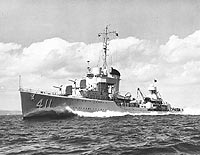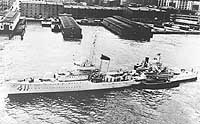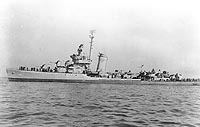
USS Anderson, a 1570-ton Sims class destroyer built at Kearny, New Jersey, was commissioned in May 1939. She served in the Atlantic and Caribbean area into April 1940, then transited the Panama Canal to take up duties in the Pacific. With several other ships, she was sent back through the canal in June 1941 to reinforce the Navy's forces in the North Atlantic. During the last months of the year, both before and after war formally began with Germany on 11 December, she escorted convoys to and from Iceland, took part in anti-submarine actions, and carried out patrols.
Anderson returned to the Pacific in early 1942 and remained in that ocean for the rest of her service. She accompanied the carrier Yorktown in the south Pacific in March and April, was part of USS Lexington's screen during the Battle of the Coral Sea in early May and was back with Yorktown a month later for the Battle of Midway. When the carrier Hornet was sent to join in the Guadalcanal campaign, Anderson went along and generally operated with Hornet until her loss in the late October 1942 Battle of the Santa Cruz Islands.
For the rest of the Guadalcanal Campaign, and beyond, Anderson remained in the south Pacific, screening heavy ships, escorting convoys, bombarding the enemy ashore and carrying out patrols. She returned to the U.S. for overhaul in March 1943 and went north for Aleutians' operations during July-September. The destroyer's next assignments were to support the invasions of the Gilbert Islands in November 1943 and the Marshalls in early 1944. She was hit by Japanese coast-defense gunfire while bombarding Wotje on 30 January. Further damaged by grounding two days later, Anderson was under repair until mid-June 1944. July-November 1944 was spent with the Seventh Fleet, including participation in landings at Morotai and Leyte. During the latter operation, on 1 November, she was hit by a Japanese suicide plane and again had to return to the U.S. for repairs.
Back in service in the Spring of 1945, Anderson was assigned to the North Pacific theatre, where she participated in a number of bombardments and anti-shipping sweeps. Following Japan's surrender, she took part in occupation activities for a few months before steaming eastward across the Pacific to San Diego, California. In early 1946, Anderson voyaged back to Pearl Harbor, where she stayed until May, then proceeded on to the Marshall Islands for use as a target ship in the upcoming "Operation Crossroads" nuclear weapons tests. USS Anderson was sunk on 1 July 1946 by the "Able" atomic bomb explosion at Bikini Atoll.
USS Anderson was named in honor of Rear Admiral Edwin A. Anderson (1860-1933), who received the Medal of Honor for combat service at Vera Cruz, Mexico in 1914 and commanded the Asiatic Fleet in 1922-1923.
This page features all the views we have concerning USS Anderson (DD-411).
| If you want higher resolution reproductions than the digital images presented here, see: "How to Obtain Photographic Reproductions." |
Click on the small photograph to prompt a larger view of the same image.
|
Photo #: NH 96119 USS Anderson (DD-411) Steaming at high speed during her trials, 1939. Note that her Mk.37 gun director has not yet been installed. U.S. Naval Historical Center Photograph. Online Image: 93KB; 740 x 600 pixels |
 |
|
Photo #: NH 67498 USS Anderson (DD-411) Photographed in New York Harbor, circa 1939-1940. Courtesy of Donald M. McPherson, 1969. U.S. Naval Historical Center Photograph. Online Image: 99KB; 740 x 485 pixels |
 |
|
Photo #: 80-CF-2156-1 USS Anderson (DD-411) Underway during a Neutrality Patrol, 29 June 1941. Photographed from USS Wasp (CV-7). Note her unusual paint scheme: overall No. 5 Navy Gray on vertical surfaces, with all identifying markings painted out. This was done as a security measure prior to her transiting the Panama Canal earlier in the Spring. Photograph from Department of the Navy collections in the U.S. National Archives. Online Image: 81KB; 740 x 605 pixels Reproductions of this image may also be available through the National Archives photographic reproduction system. |
 |
|
Photo #: 80-G-405267 USS Anderson (DD-411) Underway in the Atlantic in August 1941. Photographed from USS Wasp (CV-7). Official U.S. Navy Photograph, now in the collections of the National Archives. Online Image: 82KB; 740 x 605 pixels Reproductions of this image may also be available through the National Archives photographic reproduction system. |
 |
|
Photo #: 19-N-84296 USS Anderson (DD-411) Photographed in March 1945. Photograph from the Bureau of Ships Collection in the U.S. National Archives. Online Image: 58KB; 740 x 495 pixels Reproductions of this image may also be available through the National Archives photographic reproduction system. |
 |
|
Photo #: 80-G-16668 Battle of the Coral Sea, May 1942 Explosion amidships on USS Lexington (CV-2), 8 May 1942. This is probably the explosion at 1727 hrs that took place as the carrier's abandonment was nearing its end. Ships standing by include the cruiser Minneapolis (CA-36) and destroyers Morris (DD-417), Anderson (DD-411) and Hammann (DD-412). Official U.S. Navy Photograph, now in the collections of the National Archives. Online Image: 83KB; 740 x 605 pixels Reproductions of this image may also be available through the National Archives photographic reproduction system. Note: The original print is reversed. Orientation has been corrected in this digital image. |
 |
|
Photo #: 80-G-16669 Battle of the Coral Sea, May 1942 Smoke rises soon after an explosion amidships on USS Lexington (CV-2), 8 May 1942. This is probably the explosion at 1727 hrs that took place as the carrier's abandonment was nearing its end. Ships standing by include the cruiser Minneapolis (CA-36) and destroyers Morris (DD-417), Anderson (DD-411) and Hammann (DD-412). Official U.S. Navy Photograph, now in the collections of the National Archives. Online Image: 83KB; 740 x 590 pixels Reproductions of this image may also be available through the National Archives photographic reproduction system. |
 |
|
Photo #: 19-N-26590 (cropped) Charleston Navy Yard, South Carolina Destroyers fitting out and refitting alongside the Navy Yard piers in January 1942. These ships are (from left to right): USS Tillman (DD-641), commissioned 9 June 1942; probably USS Beatty (DD-640), commissioned 7 May 1942; probably USS Hobson (DD-464), commissioned 22 January 1942; USS Anderson (DD-411); USS Hammann (DD-412); and USS Mustin (DD-413). Note that the three incomplete ships at left are painted in Measure 12 camouflage, while those refitting (at right) wear Camouflage Measure 12 (Modified). This image is cropped from Photo # 19-N-26590, which shows USS Morris (DD-417). Note (in the left foreground, atop her Mark 37 gun director) the bracket for the antenna of an FD radar. Photograph from the Bureau of Ships Collection in the U.S. National Archives. Online Image: 138KB; 1200 x 510 pixels Reproductions of this image may also be available through the National Arc |
 |
| If you want higher resolution reproductions than the digital images presented here, see: "How to Obtain Photographic Reproductions." |
Page made 21 January 2002
New image added 8 September 2006